Get Your ALL ACCESS Shop Pass here →
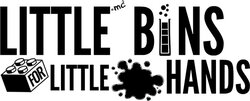

Water Filtration Lab

Learn about filtration and make a DIY water filter with this hands-on science experiment. This water filtration activity is perfect for kids in grades 3-6 and can even be turned into a fantastic science fair project !

STEM water filtration project
Water filtration is just one method our local water departments use to provide safe drinking water. These systems rely on various layers of materials, such as charcoal, sand, and even plants, to remove impurities.
In this water filtration lab, we’ll use simple household items like coffee filters and cotton balls to explore how filtration works. While it won’t make the water safe to drink, this project gives a clear visual representation of how the process works. Let’s get started and see how clean we can get our water!
What is Water Filtration?
Water filtration is the process of removing or reducing particles, bacteria, algae, viruses, and other contaminants to produce clean, usable water. In this project, we’ll simulate the process using basic materials to remove dirt and larger particles.
Note : This method is NOT SAFE for drinking, but it’s a great visual representation of filtration.
DIY Water Filter Activity
Explore both ecology and physical science ( separating mixtures and properties of materials) in one fun science experiment.
Recommended Grade Range: 3rd-6th Grade
- Plastic bottle (water or soda with the cap removed)
- Scissors or knife
- Coffee filters
- Rubber band
- Cotton balls
- Rice (optional: use aquarium gravel, small pebbles, activated charcoal, or sand instead)
- Dirt and debris
- Clear jar or cup (to catch filtered water)
- Paper towels
💡 Note: Activated charcoal and aquarium gravel can be found at a pet store.
💡 Note: You can also use a water sample from a nearby pond, lake, or stream!
Homemade Water Filter Instructions:
🛑 STOP: Only adults should use the scissors or knife to cut the plastic bottle
STEP 1: Cut the bottom off of your water bottle. Turn it upside down to create a funnel shape with the mouth of the bottle and place the top half into a clear container (or use the bottom half of the plastic bottle).

STEP 2: Mix a cup of dirt with a cup of water. Stir and let it sit for 5 minutes. You can add crumbled debris such as leaves or twigs for larger particles. Cooking oil is another option to create dirty water, and you can also investigate oil spill experiments.

STEP 3: Crumple one coffee filter and stuff it into the neck of the bottle.
STEP 4: Place 6 cotton balls on top of the coffee filter.

STEP 5: Add a cup of rice (or a cup of sand, gravel, etc) to the bottle.
STEP 6: Place another coffee filter around the top of the bottle and secure it with a rubber band.

STEP 7: Now, pour your dirty, muddy water into the bottle and observe what happens as it passes through the layers.
STEP 8: Re-filter the water several times, observing and noting the water’s appearance after each round of filtration. Take pictures or write down your observations.

💡 Challenge: Can you redesign the filter to make it more effective? Try using different filtration materials or changing the order of the layers!
Turn It Into a Science Fair Project!
Science projects are a great way for students to demonstrate their understanding of scientific concepts while following the scientific method . Here’s how you can turn this water filtration activity into a science fair project !
Create a Hypothesis : For example, “If a filter uses both cotton balls and sand, then it will clean the water better than using only cotton balls.”
Identify Variables : Read more about independent, dependent, and controlled variables [here] .
- Independent Variable : The filtration materials (cotton balls, coffee filters, sand, gravel, etc.)
- Dependent Variable : The cleanliness of the filtered water (measured by clarity, TDS meter, or other tools).
- Control : Use the same amount of dirt and water for each filter test.
Collect Data :
- Test different materials to find out which combination filters water most effectively.
- Record your observations each time you filter the water (e.g., how clear it is, how fast it filters, etc.).
- Use a chart or graph to compare results after each round of filtration.
Analyze Results :
- Does the order of materials make a difference? Why or why not?
- Do some materials filter smaller particles better than others?
Present Your Findings : Check out our model science fair board [here] .
- Create a science fair display board showing your water filter model.
- Include before-and-after photos of the water, a chart showing your results, and an explanation of how filtration works.

STEM Challenge Extensions for Older Students
Older students will be able to use the engineering design process to guide the challenge. Grab the free printable design process guide to get started.
💡 Tip: For older students, slow down the water flow by experimenting with different materials. The slower the flow, the cleaner the water may become!
You can provide students with a variety of filter materials such as:
- Aquarium gravel
- Small pebbles and rocks of different sizes
Questions to Ask :
- Does the order of materials matter in how well the water is filtered?
- Do different materials filter larger or smaller particles?
- What happens if you run the water through the filter more than once?
- Can you think of other ways to filter water?
More Water Science Experiments
Want to extend the learning beyond the water filter? Here are some ideas:
- Polluted Water Experiment : Collect trash during a nature walk, fill a jar with water, add the trash, and observe what happens over time.
- Real-World Water Filters : Research how cities and countries use filtration to provide clean drinking water. How do their systems compare to your DIY filter?
- The Water Cycle : Connect the water filter activity to a lesson on the water cycle, explaining how evaporation, condensation, and precipitation help clean water naturally.
FREE WATER FILTRATION PROJECT LESSON!
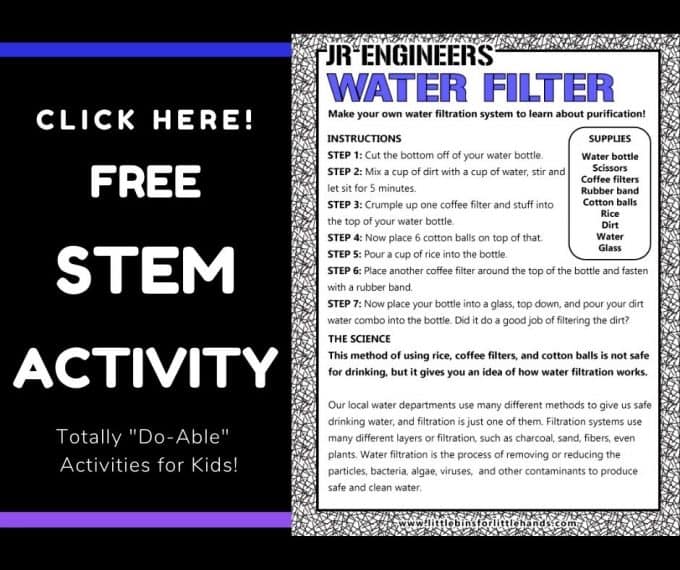
More Helpful Science Resources
Here are a few resources to help you introduce science more effectively to your kiddos or students and feel confident when presenting materials. You’ll find helpful free printables throughout.
- Best Science Practices (as it relates to the scientific method)
- Science Vocabulary
- 8 Science Books for Kids
- All About Scientists
- Science Supplies List
- Science Tools for Kids
- Scientific Method for Kids
- Easy Science Fair Projects
- Citizen Science Guide
- Join us in the Club
Printable Science Projects For Kids
If you’re looking to grab all of our printable science projects in one convenient place plus exclusive worksheets and bonuses like a STEAM Project pack, our Science Project Pack is what you need! Over 300+ Pages!
- 90+ classic science activities with journal pages, supply lists, set up and process, and science information. NEW! Activity-specific observation pages!
- Best science practices posters and our original science method process folders for extra alternatives!
- Be a Collector activities pack introduces kids to the world of making collections through the eyes of a scientist. What will they collect first?
- Know the Words Science vocabulary pack includes flashcards, crosswords, and word searches that illuminate keywords in the experiments!
- My science journal writing prompts explore what it means to be a scientist!!
- Bonus STEAM Project Pack: Art meets science with doable projects!
- Bonus Quick Grab Packs for Biology, Earth Science, Chemistry, and Physics
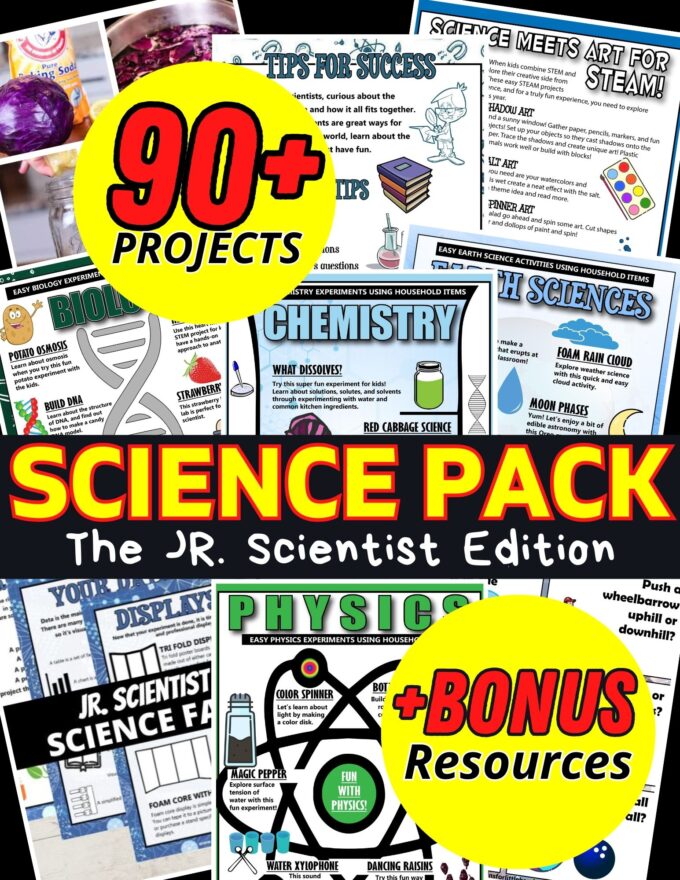
Subscribe to receive a free 5-Day STEM Challenge Guide
~ projects to try now ~.
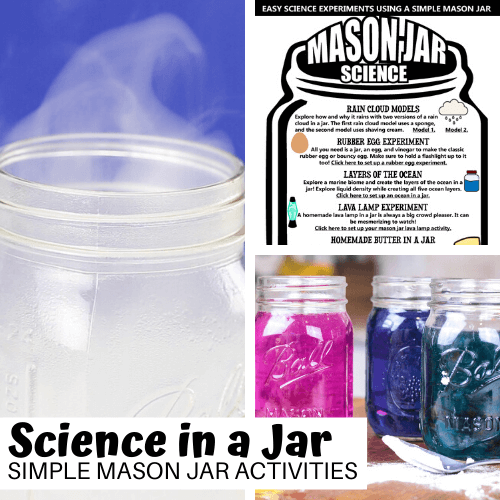
Make a water filter
This fun science experiment turns dirty water clean. (Kind of.)
How do you clean up dirty water?
Not with soap! You need a filter, a device that removes impurities, like dirt, from water. The filter you’ll make here—with the help of an adult—is a super strainer, and it’ll help you clean up your act.
Ask a grown-up to cut the bottle in half. Then flip the bottle's top half over and put it in the bottom, so the top looks like a funnel. You'll build your filter in the top part.
Place the coffee filter (or bandanna, sock, etc.) at the bottom of your filter.
Add cotton balls, charcoal, gravel, sand, and / or other materials in layers. You can use just one of them or all of them. Tip: Think about which order to add them. Bigger filter materials usually catch bigger impurities.
Write down which filter materials you used and in what order you layered them.
Stir your dirty water and measure out a cup of it.
Get your timer ready!
Pour a cup of dirty water into your filter. Start the timer as soon as you begin pouring.
Time how long it takes for all the water to go through the filter. Then write down how long it took.
Carefully scoop out the filter materials, one layer at a time. What did each layer take out of the water?
Experiment! Clean the bottle and try again. Put the filter materials in a different order each time, and time each experiment. What do you discover?
WHAT'S GOING ON?
The slower, the better! The longer it takes for water to move through a filter, the cleaner it gets. Water slips easily through the filter materials, but bigger gunk, like dirt, gets trapped. The filter materials usually get finer and finer, so they can catch whatever was missed earlier. Activated charcoal can be near the end of the water’s path, because it uses an electrical charge to grab particles too small for us to see.
Your filtered water is not clean enough to drink. But a plant will love it!
Photographs by Mark Thiessen / NG Staff: Adapted from the Nat Geo Kids book How Things Work , by T.J. Resler
(AD) How Things Work: Then and Now
How things work, (ad) how things work: inside out, (ad) get the book.
- Terms of Use
- Privacy Policy
- Your California Privacy Rights
- Children's Online Privacy Policy
- Interest-Based Ads
- About Nielsen Measurement
- Do Not Sell My Info
- National Geographic
- National Geographic Education
- Shop Nat Geo
- Customer Service
- Manage Your Subscription
Copyright © 1996-2015 National Geographic Society Copyright © 2015-2024 National Geographic Partners, LLC. All rights reserved
- Skip to primary navigation
- Skip to main content
- Skip to primary sidebar

- FREE Experiments
- Kitchen Science
- Climate Change
- Egg Experiments
- Fairy Tale Science
- Edible Science
- Human Health
- Inspirational Women
- Forces and Motion
- Science Fair Projects
- STEM Challenges
- Science Sparks Books
- Contact Science Sparks
- Science Resources for Home and School
Homemade Water Filter Experiment
July 6, 2019 By Emma Vanstone 11 Comments
Today we are looking at filtering and how it can be used to clean dirty water. This water filter science project is very simplified but gives kids a great overview of how water purification is carried out to give us lovely clean drinking water.
Do not drink the water in the activity
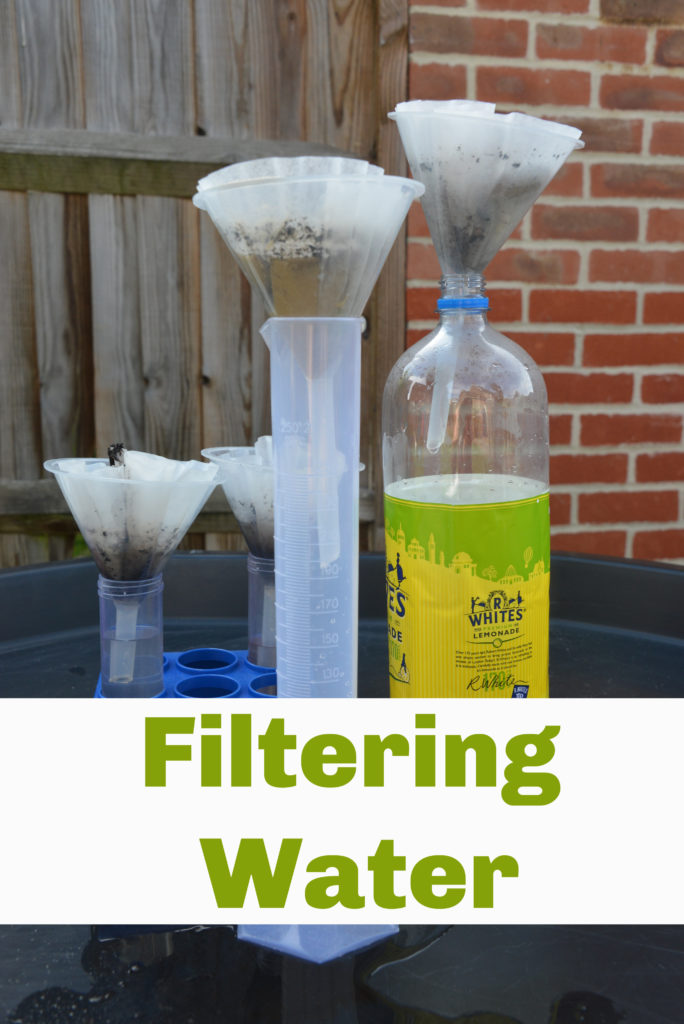

Water Filter Science Project
Filtering water – what you need.
Dirty water ( or mud and clean water )
Coffee filter/paper towel/muslin
An empty bottle or other containers
Filtering Water Experiment
The great thing about this experiment is that you can design it however you like.
We set up coffee filters containing sand, stones and then just plain filters.
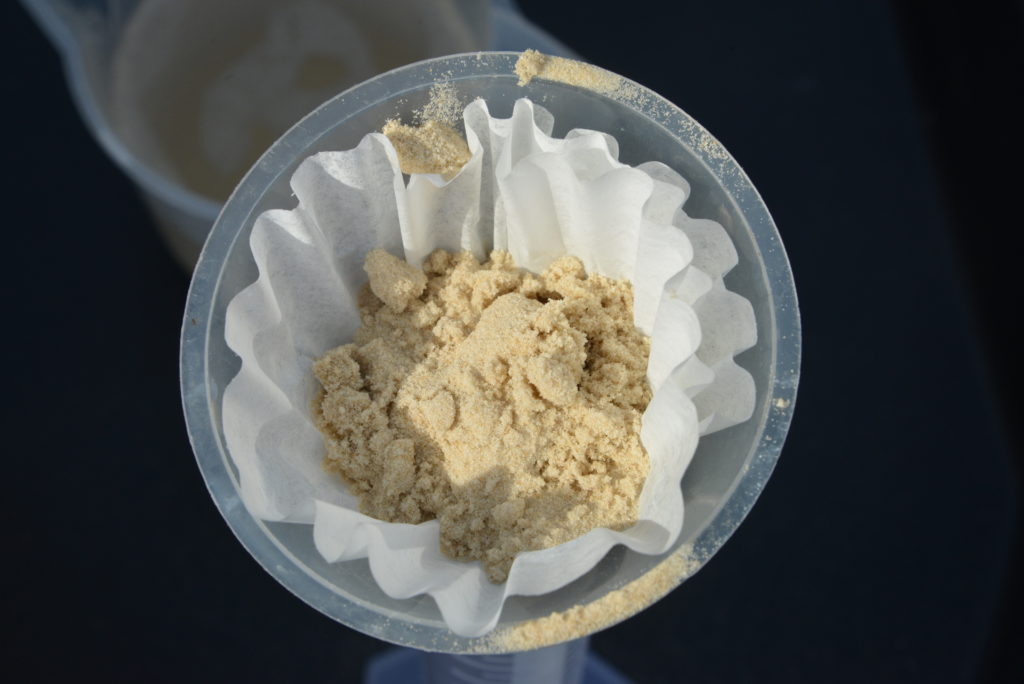
We carefully poured the same amount of water through each filter and observed the results.
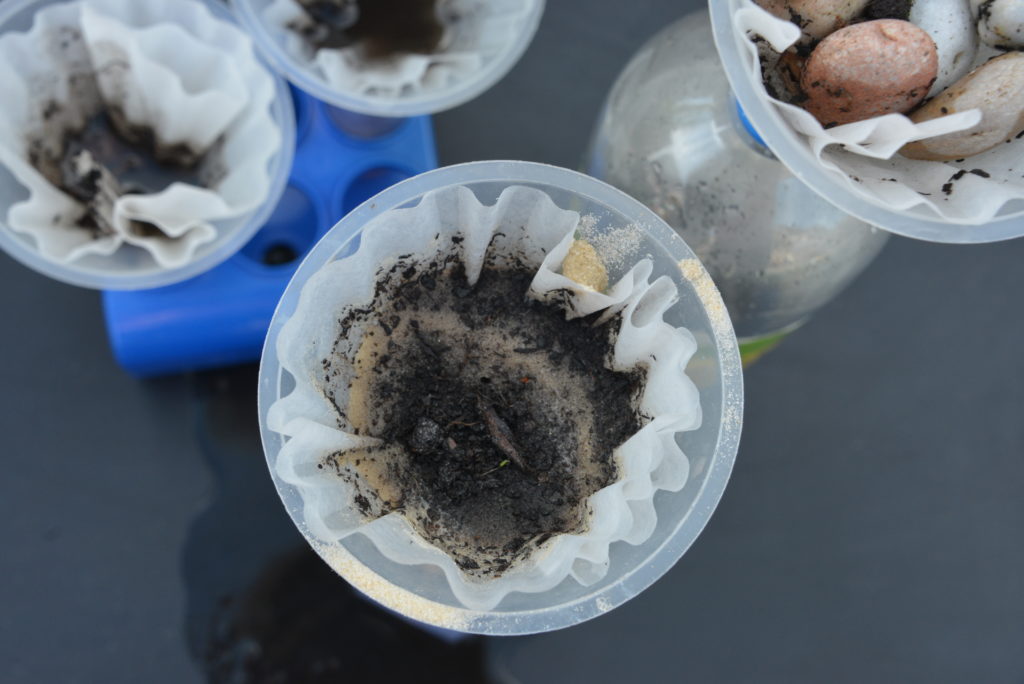
More ideas to try – Water Filter Science Project
Set up an experiment where the conditions are:
1 coffee filter
2 coffee filters
3 coffee filters
Is kitchen roll better than a coffee filter, would just a sieve work?
You could also work in stages, so try a colander, then a sieve and then a paper towel. Each stage should trap smaller and smaller particles.
How do filters work?
A filter is a porous material which a liquid can be passed though to separate the liquid from solids suspended in it.
More Filtering Investigations
Make a toy filter .
Try filtering potions using a sieve and colander.
Can you filter water using sand and stones ?
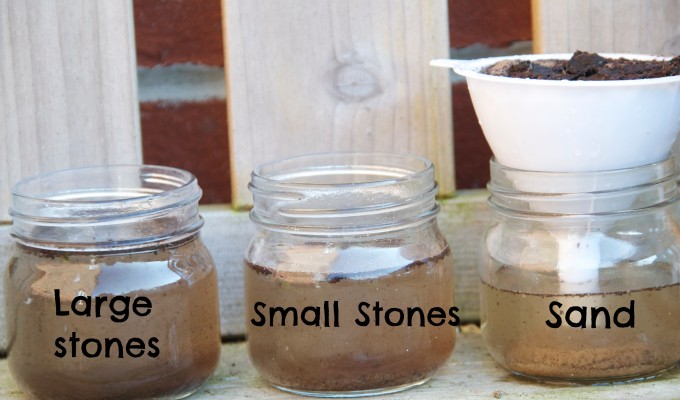
More Science for Kids
I’ve got a fun collection of water science experiments , including a water cycle activity, dissolving experiment, ice investigation and density trick!
Try one of our easy science experiments for kids to do at home ! We’ve got egg experiments, ice experiments, paper helicopters, STEM challenges and lots more science fun for kids of all ages!
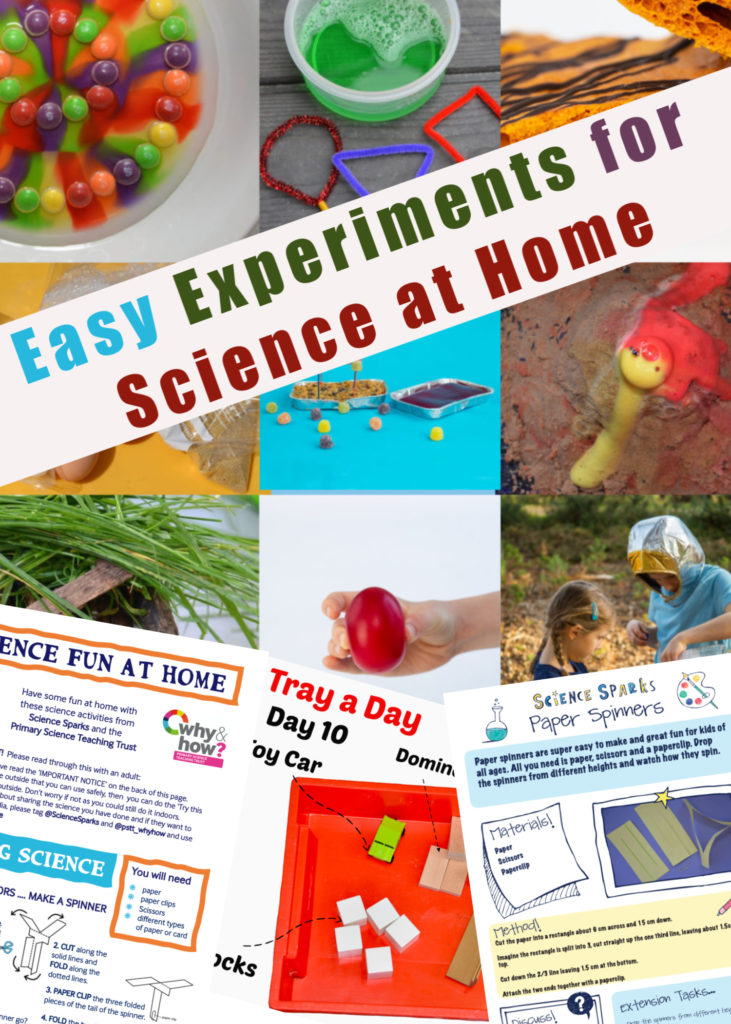
Suitable for Key stage 2 Science
Properties and Changes of Materials
Use knowledge of solids, liquids and gases to decide how mixtures might be separated, including through filtering, sieving and evaporating.
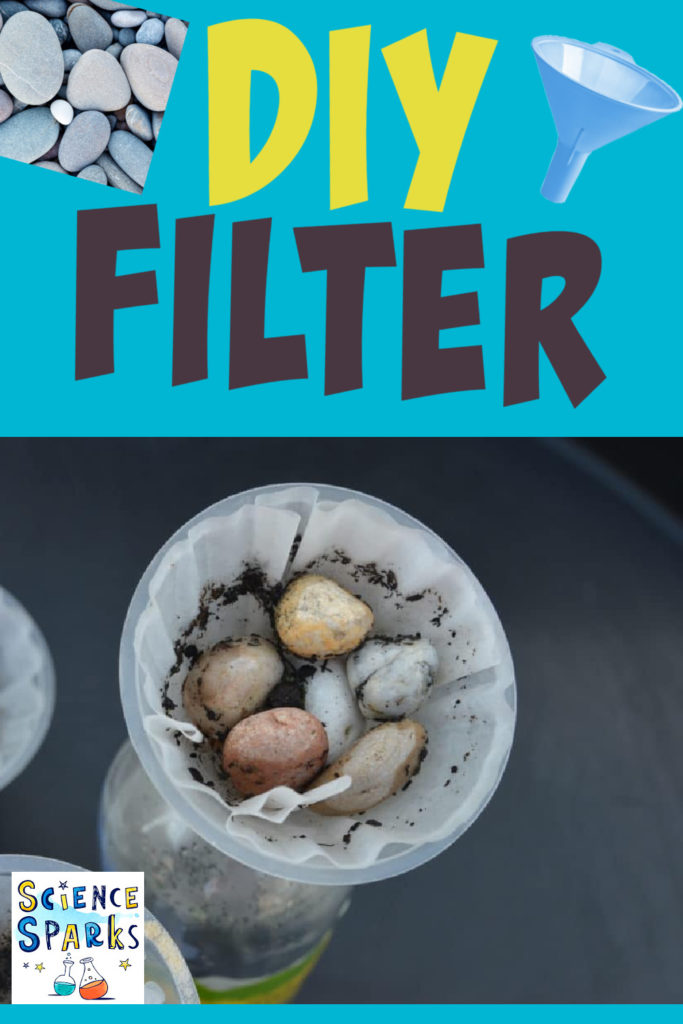
Last Updated on August 6, 2024 by Emma Vanstone
Safety Notice
Science Sparks ( Wild Sparks Enterprises Ltd ) are not liable for the actions of activity of any person who uses the information in this resource or in any of the suggested further resources. Science Sparks assume no liability with regard to injuries or damage to property that may occur as a result of using the information and carrying out the practical activities contained in this resource or in any of the suggested further resources.
These activities are designed to be carried out by children working with a parent, guardian or other appropriate adult. The adult involved is fully responsible for ensuring that the activities are carried out safely.
Reader Interactions
May 15, 2012 at 11:49 pm
This is such a neat experiment. I bet it would be fun to let the kids think of better ways to filter the water. It will definitely give them a better appreciation for our clean water!
May 18, 2012 at 8:22 pm
So simple, and yet so fun! A very good way to learn about filters and clean water. We will definitely have to try this one, thanks 🙂
May 22, 2012 at 8:21 pm
We did that once too and it’s amazing how much gets filtered out and how gross that water still is. I think yours was more easily visble, we have very clay like dirt, so it didn’t quite dissolve right. Thanks for linking up to Science Sunday!
Leave a Reply Cancel reply
Your email address will not be published. Required fields are marked *
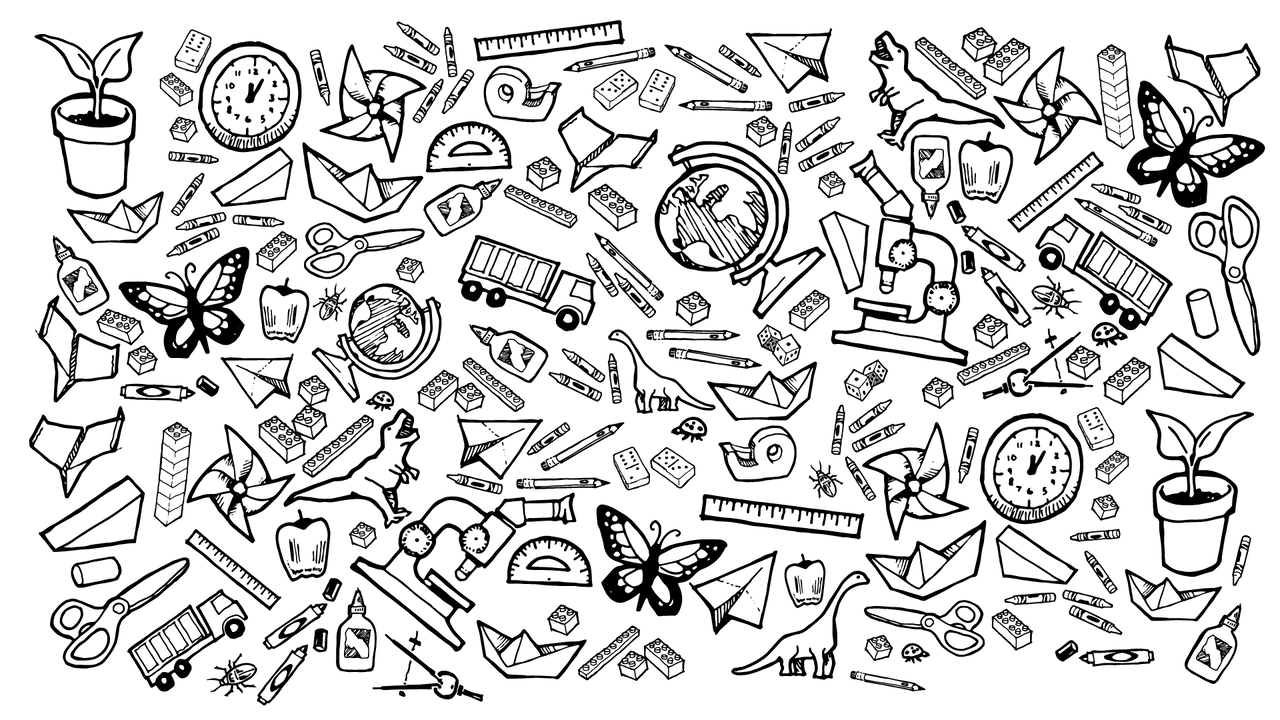
Water Filter Science Experiment
June 18, 2024, start the conversation, categories/tags:, ages 8-10 ages 11+ stem activities, want these great ideas sent right to your inbox sign up for the newsletter., this water filter science experiment is the perfect addition to any earth science unit.
It’s easy to do, and students of all ages will enjoy this science activity. I would recommend this experiment for students ages 10+ to do mostly on their own. It would be perfect for middle school. However, younger kids from first grade on can benefit from this experiment with some adult help!
It’s good to be reminded what it takes to get dirty water clean! Having access to clean water is something we should not take for granted. We should also consider what we are adding to the water in our community.
Before doing this experiment, I watched a few videos and read a few articles online to see how others have approached this water filter science experiment. Then we conducted the experiment more than once and adjusted our procedure along the way.
This process reminded me of two things that I really want to share with you all:
- There is a LOT of fake science on Instagram and YouTube (and probably TikTok too but I’m not on there).
- Conducting experiments is far more valuable than watching a video of someone else carrying out the experiment.
Now, please hear me out a minute on that second one. Videos absolutely have their place. There are times that you won’t be able to get the supplies needed or don’t have the time or skill to set up a certain lab. My point is simply that watching videos removes the student from the scientific process. They become outside observers rather than experimenters. They also miss out on the opportunity to develop skills in following directions, scooping, pouring, measuring, cutting, taping, and building scientific apparatuses.

How to Do the Water Filter Science Experiment
When I began researching this experiment, I quickly found that most people follow roughly the same process.
The first video that I watched showed someone pouring very dirty water into a filter they had made in a bottle, just like ours. The water quickly ran through the filter and came out crystal clear!
After carrying out this experiment multiple times, I can confidently say that that video HAD to have been rigged.
The reality is that it takes several minutes for the water to go through the filter. Maybe 10-15 depending on how thick your filtering layers are.
Also, it’s a challenge to get the water completely clear.
However, this experiment still has so much value for students. We learned so much! And there are several variables that you can modify to create a true experiment (rather than a simple demonstration).
Supplies Needed for Making a Water Filter:
- A plastic bottle – we used a 1.25 liter soda bottle
- Coarse sand
- Cotton balls
- A utility knife
- Three craft sticks
- Jar or glass (optional)

We used a 1.25 liter soda bottle, and it worked well. A 2 liter bottle is fine too, but just keep in mind that if your bottle is larger, you’ll need more of all the supplies to fill it.
I used my kitchen strainer to separate our play sand into fine sand and coarse sand.
My husband used a hammer to crush some charcoal. Barbeque charcoal is fine to use! Just make sure it’s not the type with lighter fluid already added.
How to Set up Your Filtration Bottle:
I will show you the apparatus we built, and then explain why we switched to a glass instead.
Cut 3-4 inches off the bottom of your bottle.
Then use craft sticks to attach the upside down bottle to the bottom of the bottle as shown. We taped the craft sticks in place.

Once we started the water filtration experiment, our bottle ended up falling over and breaking the sticks (due to user error!), so we ended up switching to just having the bottle upside down in a glass.
I really do like this setup, though, and if you’re doing this with a class it will save you from having to have a bunch of glasses or jars.
This water filter uses different materials to trap the dirt particles in the water.
Start with cotton balls in the bottom of the jar. Then add a layer of crushed charcoal. The charcoal will absorb impurities in the water, and the cotton filters out some of the smallest particles.
NOTE: While you may be able to filter out a lot of dirt from your water, this filtering process will NOT get rid of bacteria or viruses in the water. Don’t drink the water you filter unless you boil it first!

Here’s how we built our layers.

Kids will probably be very curious about why we’re using dirt and rocks to make water clean! The gravel will trap the largest particles in the dirty water. Then the sand will filter out smaller particles. The charcoal will absorb impurities in the water, and the cotton will filter out some of the smallest particles.
Now it’s time to test your filter!
Pour some muddy water into your filter.

It will take several minutes for the water to start dripping out the bottom of the bottle! This is not an instant process. The water must seep through each of the layers.
Here’s the water we collected the first time using our filter:

I still wouldn’t want to drink that, but we were all really impressed with how much dirt we filtered out.
Here’s what happened when I took the water from the glass and poured it back through the filter a second time:

Much cleaner!
I ran the water through 4 more times, but interestingly enough it didn’t ever appear to be any cleaner after that second trip through the filter.
So then we tried building a new filter to see if a fresh filter would make the water clear.
It didn’t make a difference!
This seems to be as clean as we can get our water with our filter. The type of play sand available here in Texas stains hands and feet a brown color. So I’m wondering if the sand in our filter was part of the problem.
Add Variables to Make This Water Filter a True Experiment
There are a number of things you can vary in the setup of the filter to make it a true experiment!
- Does the dirtiness of the water affect how clean it becomes in the end? If you start with water that is just a little dirty, can you get it to come out clear? (We used REALLY dirty water!)
- Will the filter work more effectively if you increase the thickness of the layers of filtering material? Kids could experiment with increasing the depth of one layer at a time, or they can increase all the layers.
- Will the filter work more effectively if you substitute coffee filters for the cotton material in the bottom of the bottle?
More Earth Science Experiments:
Find out Why Rivers Develop Curves with this simple experiment!
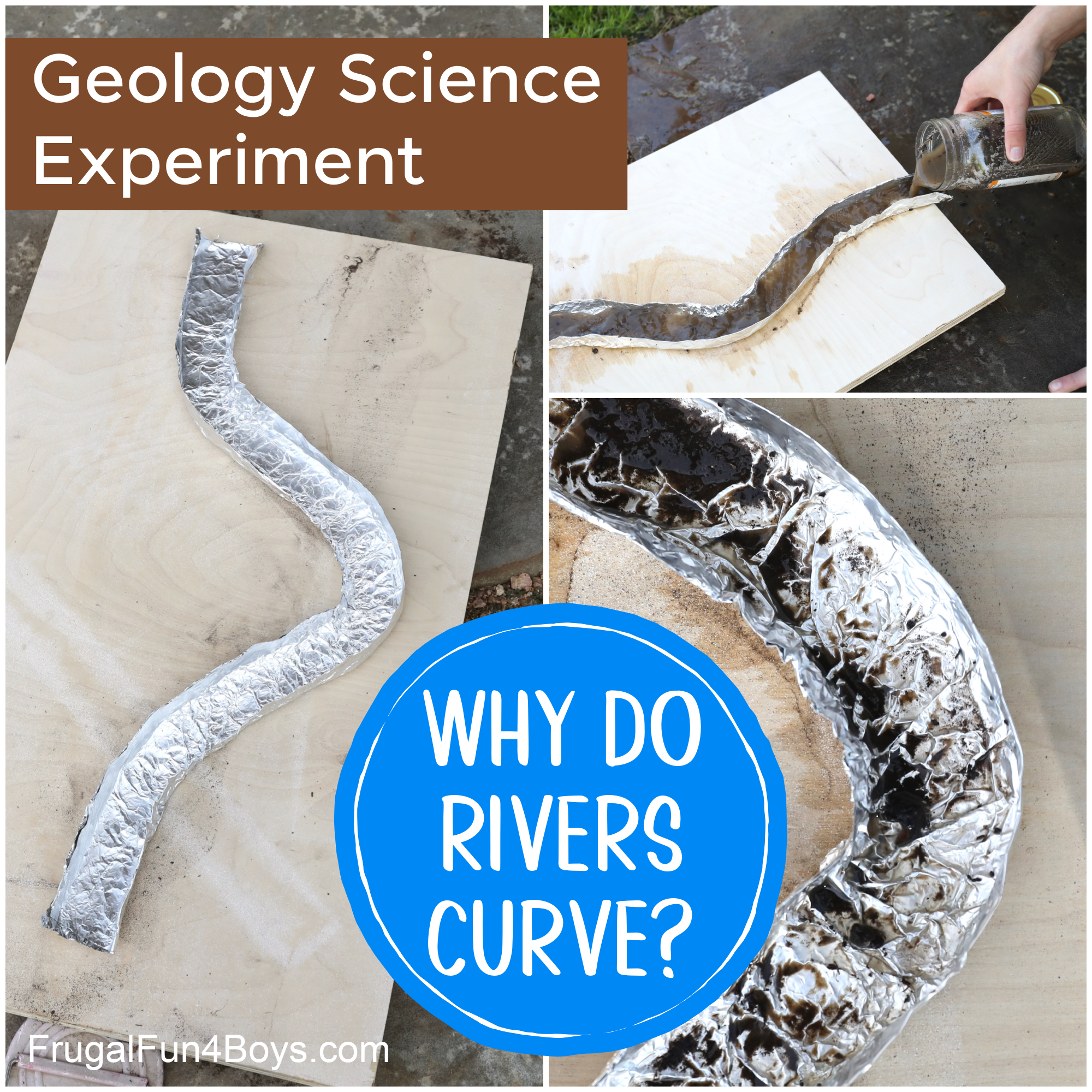
Students will love seeing Why is the Sky Blue ? with this easy science demonstration.
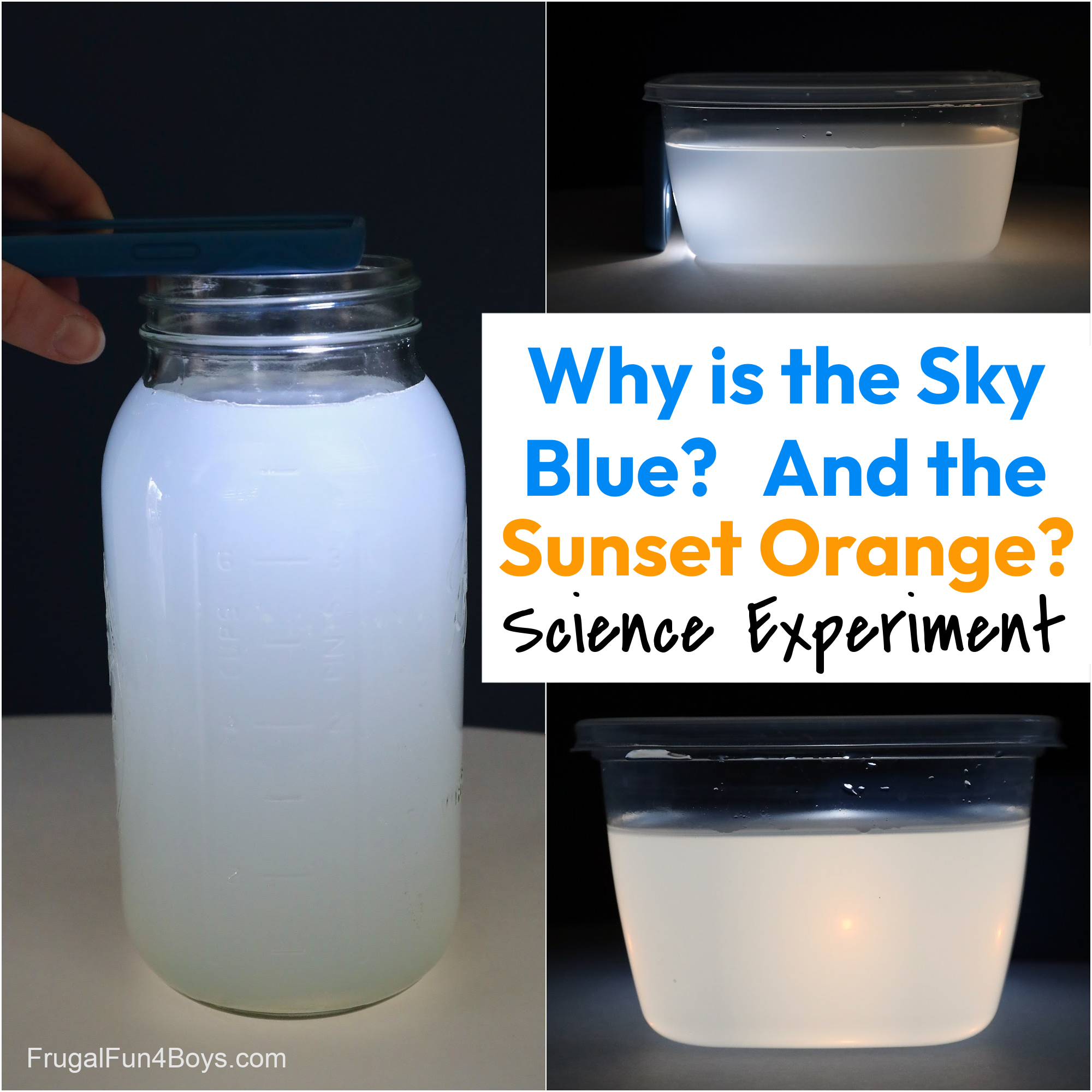
Post a Comment

IMAGES
COMMENTS
Nov 3, 2020 · Make your own water filter using simple materials. This activity is a perfect science experiment or science project on water filtration. Materials needed are...
Construct your own sand water filter and learn about water filtration systems with this easy science project.http://www.hometrainingtools.com/water-purificat...
Where did you get your water today? Was it clean and safe to use and drink? Sydney Water filters your drinking water every day, so you don’t have to! Using r...
DIY Water Filtration System for Science Project. Pour swamp water in the 2-liter bottle with a lid. Notice how it looks and smells. Put the lid on the bottle and shake vigorously for 30 seconds. Then pour the water back and forth between the two cups about 10 times. Pour the water into the bottle with its top cut off.
Sep 23, 2024 · STEM water filtration project. Water filtration is just one method our local water departments use to provide safe drinking water. These systems rely on various layers of materials, such as charcoal, sand, and even plants, to remove impurities. In this water filtration lab, we’ll use simple household items like coffee filters and cotton balls ...
This video accompanies the How Natural Areas Filter Water lesson on Nature Lab.
The slower, the better! The longer it takes for water to move through a filter, the cleaner it gets. Water slips easily through the filter materials, but bigger gunk, like dirt, gets trapped. The filter materials usually get finer and finer, so they can catch whatever was missed earlier. Activated charcoal can be near the end of the water’s ...
Jul 6, 2019 · Sand Filter Stone Filter. We carefully poured the same amount of water through each filter and observed the results. Stone filter More ideas to try – Water Filter Science Project. Set up an experiment where the conditions are: 1 coffee filter. 2 coffee filters. 3 coffee filters. Is kitchen roll better than a coffee filter, would just a sieve ...
How to Filter Water DIY Science Experiments for Kids! Ryan ask Peck to find a way to water filter into clean water! Fun Science Experiments to do at home tha...
Jun 18, 2024 · The first video that I watched showed someone pouring very dirty water into a filter they had made in a bottle, just like ours. The water quickly ran through the filter and came out crystal clear! After carrying out this experiment multiple times, I can confidently say that that video HAD to have been rigged.